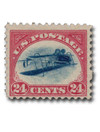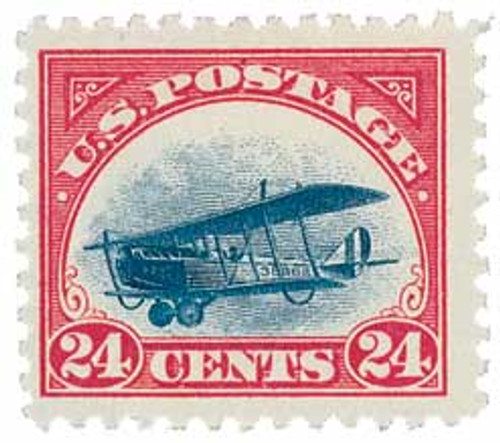
# C3a - 1918 24c Jenny Invert
Your Chance to Own the World-Famous Inverted Jenny
“Still remarkably fresh with fine centering”
– Don Sundman
I’m proud to offer you one of the rarest, most famous, and sought-after stamps in the world – the legendary Jenny Invert.
Position 63 from the sheet of 100 #C3a stamps purchased in 1918 by William Robey is, in my opinion, the Jenny Invert with the most tantalizing history. Imagine how you would feel to be its next owner… The good news is, now you can be.
This Jenny’s story began after the outbreak of World War II. The rare Invert was owned by a British nobleman – the fourth Marquess of Bute – John Crichton-Stuart. Like any stamp collector, the Marquess worried about the safety of his stamps during the relentless Nazi bombing raids on London. But surely they would be out of danger five stories below the city streets, in the vaults of the Chancery Lane Safe Deposit?
The Error Stamp that Survived the London Blitz…
On September 24, 1940, London was ablaze following one of the heaviest German air raids of the war. While the building above the Chancery Lane Safe Deposit was destroyed by a direct hit, the concrete-reinforced and steel-lined walls of the underground vaults remained intact. But as firefighters struggled to extinguish the flames five stories above, water flooded the vaults to a depth of three feet. Luckily for the Marquess (and us collectors) this Inverted Jenny emerged unharmed except for the loss of its gum. A small thing indeed, considering the great rarity and amazing history of such a stamp.
This survivor of the London Blitz is currently valued at $280,000. Despite its harrowing experience with bombs and rushing water, our Jenny Invert remains remarkably fresh in appearance with fine centering. The minor imperfections, no gum and a tiny thin, are on the back. They don’t affect the stamp’s beauty and unquestionable desirability. They are, after all, reminders of its great age and remarkable history.
If you’re ready to be part of the Jenny Invert story, to own and safeguard this world-famous Jenny Invert Error stamp, please call today. Discuss your payment options with a friendly Customer Service Representative. Interest-free time payments are available to make ownership easier.
It’s a privilege to preserve the Jenny Invert for future generations of stamp collectors. Like me, I know you’ll find owning this 106-year-old philatelic rarity one of the most satisfying accomplishments of your life in stamps.
Your Chance to Own the World-Famous Inverted Jenny
“Still remarkably fresh with fine centering”
– Don Sundman
I’m proud to offer you one of the rarest, most famous, and sought-after stamps in the world – the legendary Jenny Invert.
Position 63 from the sheet of 100 #C3a stamps purchased in 1918 by William Robey is, in my opinion, the Jenny Invert with the most tantalizing history. Imagine how you would feel to be its next owner… The good news is, now you can be.
This Jenny’s story began after the outbreak of World War II. The rare Invert was owned by a British nobleman – the fourth Marquess of Bute – John Crichton-Stuart. Like any stamp collector, the Marquess worried about the safety of his stamps during the relentless Nazi bombing raids on London. But surely they would be out of danger five stories below the city streets, in the vaults of the Chancery Lane Safe Deposit?
The Error Stamp that Survived the London Blitz…
On September 24, 1940, London was ablaze following one of the heaviest German air raids of the war. While the building above the Chancery Lane Safe Deposit was destroyed by a direct hit, the concrete-reinforced and steel-lined walls of the underground vaults remained intact. But as firefighters struggled to extinguish the flames five stories above, water flooded the vaults to a depth of three feet. Luckily for the Marquess (and us collectors) this Inverted Jenny emerged unharmed except for the loss of its gum. A small thing indeed, considering the great rarity and amazing history of such a stamp.
This survivor of the London Blitz is currently valued at $280,000. Despite its harrowing experience with bombs and rushing water, our Jenny Invert remains remarkably fresh in appearance with fine centering. The minor imperfections, no gum and a tiny thin, are on the back. They don’t affect the stamp’s beauty and unquestionable desirability. They are, after all, reminders of its great age and remarkable history.
If you’re ready to be part of the Jenny Invert story, to own and safeguard this world-famous Jenny Invert Error stamp, please call today. Discuss your payment options with a friendly Customer Service Representative. Interest-free time payments are available to make ownership easier.
It’s a privilege to preserve the Jenny Invert for future generations of stamp collectors. Like me, I know you’ll find owning this 106-year-old philatelic rarity one of the most satisfying accomplishments of your life in stamps.







